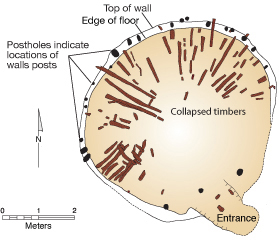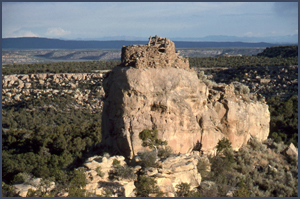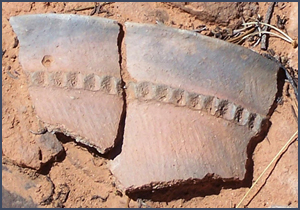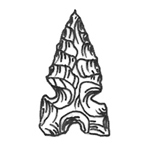Peoples of the Mesa Verde Region
The Post-Pueblo Period: A.D. 1300 to Late 1700sNavajo
The Navajo and the Apache are closely related tribes, descended from a single group that scholars believe migrated from Canada. Both Navajo and Apache languages belong to a language family called "Athabaskan," which is also spoken by native peoples in Alaska and west-central Canada. When the hunter-gatherer ancestors of the Navajo and Apache migrated south, they brought their language and nomadic lifestyle with them. Scholars disagree about the exact timing of these migrations, but it seems likely that Athabaskan speakers arrived in the Southwest after A.D. 1450 and were in the Mesa Verde region by at least the early 1500s. Although they were a single cultural group when they first arrived in the Southwest, their different experiences and the different environments in which they settled eventually resulted in their separating into two distinct groups: the Navajo and the Apache. The Navajos remained in what would become northwestern New Mexico and adjacent areas of Colorado, planting crops and adopting a more settled lifestyle that eventually included sheepherding (after sheep were introduced by the Spanish). The people who became the Apaches moved farther south and east, continuing their hunter-gatherer lifestyle. The Navajo people call themselves the Diné, or "the People." Diné origin stories say they emerged from the fourth world into the San Juan Mountains of southwestern Colorado, which border the Mesa Verde region to the northeast. The traditional Navajo homeland, which they call Dinétah, is bounded by four sacred mountains, corresponding to the four cardinal directions: Hesperus Peak (Dibé Ntsaa) to the north, Blanca Peak (Sisnaajiní) to the east, Mt. Taylor (Tsoodził) to the south, and the San Francisco Peaks (Dook’o’osłííd) to the west. The northern part of the Dinétah falls within the Mesa Verde region. 
Map of collapsed forked-pole hogan. (View photograph of a still-standing forked-pole hogan dating from a later period.) The earliest archaeological sites in the Mesa Verde region and adjacent areas that are recognizably Navajo date from the mid-1500s. The sites contain the remnants of traditional Navajo houses, called "hogans." During most of the Post-Pueblo period, conical "forked-pole" hogans predominated; very late in the period, circular masonry or cribbed-log hogans made their appearance, eventually becoming the more common form. In addition, archaeologists find plain pottery sherds, manos and metates, small pieces of chipped stone, and projectile points. Spanish chronicles from the late 1500s and early 1600s distinguish the Navajo from their Apache cousins by their more settled lifestyle and their fields of corn and other crops. Navajos borrowed and adapted traits from their Spanish and Pueblo neighbors to a much greater degree than did the Apaches. Sheep and goats introduced by the Spanish provided new sources of food and raw materials, including wool for textiles. Painted Navajo pottery from this period was decorated with Pueblo-style designs, and scholars think the Navajos learned farming and weaving from their Pueblo neighbors. The borrowing of Pueblo traits continued after the Pueblo Revolt of 1680, when some Pueblo Indians from the Rio Grande valley took refuge among their Navajo neighbors to the north and west. 
Although similar in some ways to Pueblo architecture, pueblitos were built by Navajos for defense against raiders. (See enlarged photograph.) In the early to middle 1700s, a distinctive architectural form, the pueblito, appeared in the Dinétah, mainly in northwestern New Mexico. Pueblitos are multiroom masonry structures often located in places that could be easily defended, such as canyon rims and prominent rock outcrops. Recent research suggests that, despite their name, these buildings were constructed not by Pueblo Indians but by Navajos to defend against attack by Utes and Spaniards. By about A.D. 1750 or 1760, Ute and Spanish raiding forced most Navajos out of the Dinétah in northwestern New Mexico, and they moved even farther south and west, into present-day Arizona and Utah. 
Unpainted Navajo pottery sherds dating from about A.D. 1600–1700. (See enlarged photograph.) 
This style of projectile point is found on early Navajo sites. Stone points were hafted to wooden arrow shafts.
|
|
Acknowledgments | Illustration credits | To borrow, cite, or request permission | Please take our survey! Title page for Peoples of the Mesa Verde Region |
|
 DONATE TODAY
DONATE TODAY
